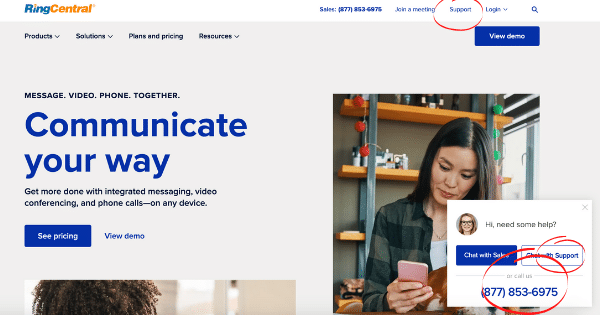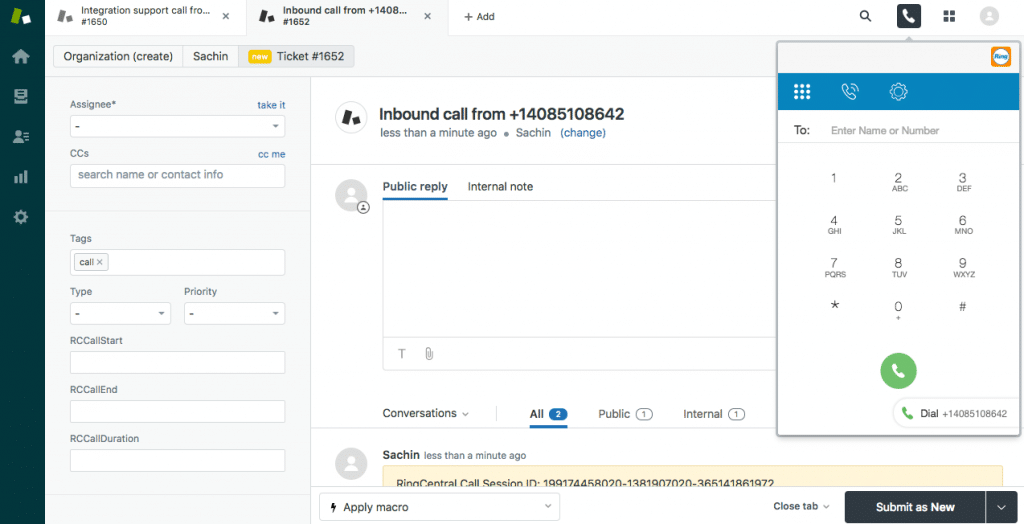In a nutshell, customer service is the way in which you open a dialogue with your customers, solve their problems, and keep them coming for more.
But you probably knew that.
What you might not know is that customer service isn’t just a support function anymore. Your business—especially if it’s small and survives mostly because of your repeat customers—has to stop looking at customer service as a cost center, and start treating it as a revenue center.
If that’s confusing, just compare the money you spend to get a new customer versus retaining an existing customer. Your math will most likely match the averages across all industries, and you’ll discover that retaining customers is up to five times cheaper than acquiring new ones.1
And if you think that’s just a wee number, you might be surprised to know that just a 5% improvement in your customer retention can increase your business revenue by 25–95%.2
Crazy, right? But that’s just the headline. The real news is that customer retention has a much deeper impact on your overall business performance.
But here’s the thing. While you could do lots of different things to influence your customer retention rate, in the end, keeping a customer is mostly a direct outcome of good customer service.
In this post, we’re going to look at eight good customer service tips examples to help you improve your support offering and keep your customers happy:
- Improve your employee experience
- Make empathy a top priority
- Offer an above-average(??) customer service
- Make your customer service accessible
- Get rid of the silos
- Measure the right metrics
- Build self-service content
- Build a direct feedback loop with customers
⭐️⭐️⭐️⭐️⭐️ Ready to offer 5-star customer service? Get strategies for every stage of the customer journey with this free eBook.
8 customer service tips if you’re tight on time (and money)
If you’re managing a small business with limited resources and/or no past business experience, you might echo the same sentiment that thousands of other business owners have:
“How do you provide ‘excellent’ customer service?”
It’s a question that haunts most first-time business owners.
Unfortunately, there isn’t a toll-free number for small businesses you can just call and get the crème de la crème of customer service tips over the phone.
One of the best ways to learn how to create an outstanding customer experience is by interacting more frequently with your customers. Or, you can also use a few tips from other businesses.
Let’s look at eight customer service tips to help you deliver exceptional customer service.
[ebook-download title=”How customer-obsessed is your business?” link=”https://netstorage.ringcentral.com/documents/quiz_how_customer_obsessed_your_business.pdf” cta-text=”Take the quiz” src=””]
1. Improve your employee experience
This isn’t a typo on the list. Employee experience has a direct and strong impact on good customer service.
Employee experience (EX) is to customer service (CX) what pizza dough is to a pizza. It’s the binding agent that holds the whole customer experience together.
Employee experience is often tossed aside as HR’s responsibility. It’s also often associated with “frivolous” activities like office potlucks, Halloween parties, or “star of the month” recognition.
In reality, EX is much more than that.
EX impacts CX because happy employees lead to happy customers.3 That’s just a fact. Companies with employee-first cultures also often have best-in-class customer service—think Zappos4 and Wegmans.5
Just look at what research data has to say about it:
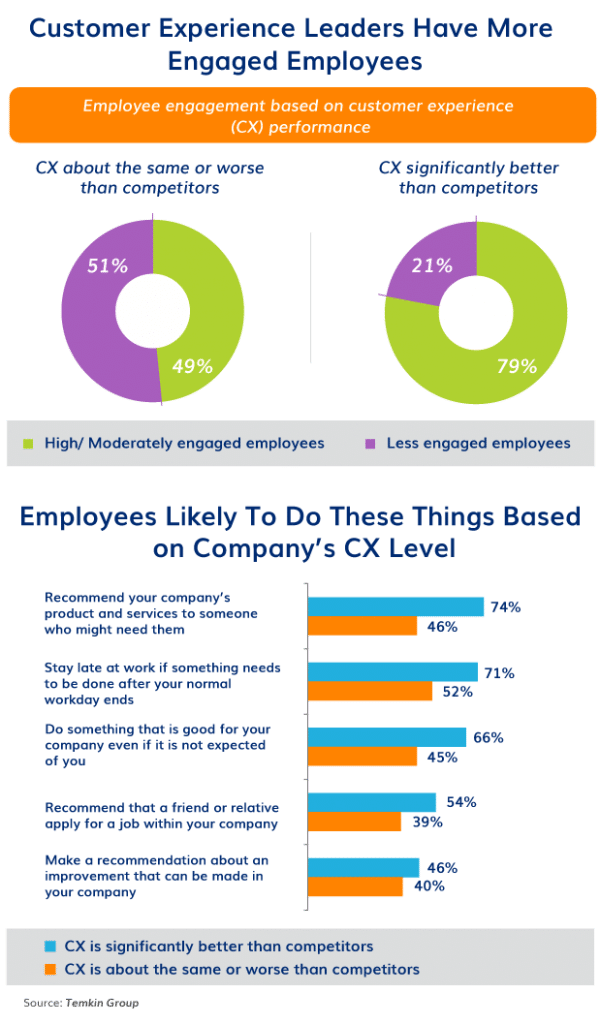
Good EX often results in loyal, engaged employees who perform beyond their paychecks and positively impact their company’s bottom line.
How you can improve the employee experience:
- Treat your employees like your first customers. Employees stick with brands that offer them a great experience; they’ll leave when it’s apparent that you’re not treating them right.
- Build an employee-centric company culture and invest in improving employee engagement. Launch employee advocacy programs, encourage employee branding, and offer incentives based on performance and/or loyalty.
- Frontline employees are the people closest to solving your customer problems. Give them reasonable authority to make decisions if it helps them offer a great customer experience, like how Nordstrom banks on its staff’s “good judgment” to deliver excellent CX.
2. Make empathy a top priority
Saying that your customer service needs empathy is like saying your music needs melody. Empathy is what makes your customer service sing.
Empathy is also one of the most sought-after skills in customer service representatives6 — even outranking product knowledge and technical skills.
And it’s easy to see why. Customers all over the world hate two things about customer service: being kept on hold and having to repeat their issues to multiple reps.7 These also happen to be tell-tale signs of customer interactions that lack empathy.
Our advice here is simple—make empathy a must-have criterion when hiring customer service reps.
But because empathy is a soft skill—not always the easiest to measure—it might be hard for you to size up the empathy levels in someone right out of the gates. Luckily, you can always train your staff to be more caring and compassionate.
How you can improve empathy in your team:
- Develop an empathy guideline to let your customer-facing teams know how to respond to customers in situations that are sensitive in nature or demand urgent attention.
- Communicate the importance of empathy to your service teams. Coach them on active listening skills and using empathy statements and/or positive language.
- You can also make learning empathy fun! Bring your service teams together to take part in empathy exercises, such as encouraging them to see two sides to everything or talking about the best and worst part of their work. Check out inspiration on a few empathy exercises.
- Most importantly, practice what you preach. Make empathy a part of your everyday company culture. Create an environment where employees can bring their whole selves at work and lean on people when they need help.
3. Offer an above-average(??) customer service
You know what makes customer service amazing?
It’s not always the over-the-top experiences where a brand sweeps its customers off their feet.
These fantastical service experiences are isolated incidents at best. And while it’s great to create such exceptional experiences when a situation calls for it, it’s not the most repeatable (or scalable) way to charm your customers.
You make your customer service great by offering an above-average customer experience—at all times. Your service offering is great when it’s predictable and consistent.
When customers contact your brand, they should think to themselves, “I know they’ll help me find a solution.”
To earn that kind of confidence from your customers, you have to first shift your focus from the extreme of “customer delight” to simply making your customer experience better.8 That’s because customer experience, or CX, is the lever that results in better business outcomes, including revenue, improved customer satisfaction, and exceptional customer service.
Some brands try really hard to impress their customers by focusing on positioning themselves as a customer-centric brand, creating a cool brand persona online, and so on.
But this often ends up becoming lip service when the company can’t actually tie the customer experience with consistent execution. The branding is there, but the customer-centric strategy is not.
In reality, it’s the little things that you do over and over to make customers look up to your brand.
How to offer a consistent, above-average service experience:
- Give your customer service reps a tool that can help them route customer queries from all channels like chat, email, phone, or social media. That way, you won’t miss a beat even when hordes of customers contact you, and you can offer a consistent experience all the time. Here’s a quick look at how this kind of contact center tool works:
- Build consistency in your brand interactions by offering your customers a uniform, unbroken experience. If a customer contacts your brand through email or phone, for instance, your team should have a way of quickly seeing that customer’s past history with your business so they don’t have to repeat their story every time they contact you.
- Meet customers on their channel of choice. Some customers hang out on Twitter while others might want to interact with your brand on Instagram. Treat those communication channels with the same care as you would a traditional phone call.
- Personalize your customer experiences. If you have a customer service app, use it to offer a little extra to each customer. It should have features that log your customers’ details and information so that you can do things like greet them by their first name, offer personalized recommendations, and wish them well on their birthdays or anniversaries.
4. Make your customer service accessible
Beneath the shiny luster of customer service that everybody likes to talk about these days, there’s another reality that lurks in the underbelly of businesses who go to lengths to avoid serving their customers.
Just take a look at this GetHuman website below:
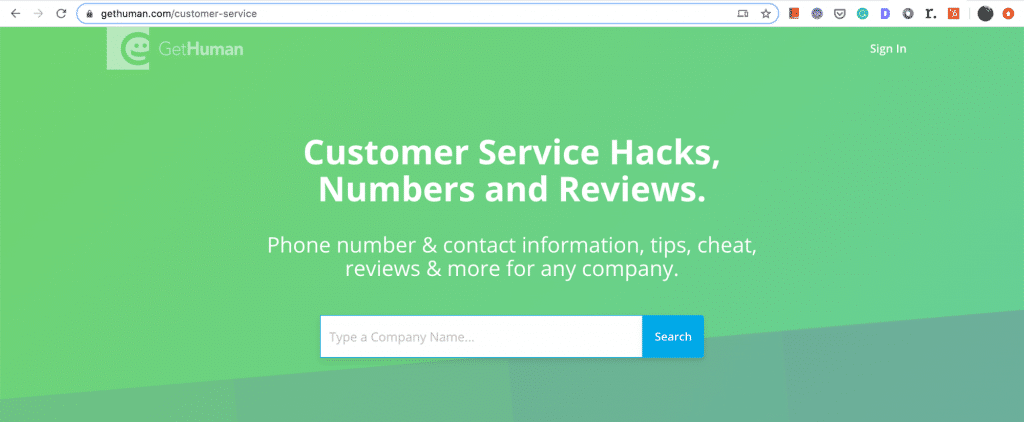
GetHuman is an online portal that helps customers get in touch with the customer teams of brands that deliberately try to hide their customer support.
And although GetHuman is fighting the good fight by helping stranded customers contact a brand’s customer service, it’s kind of sad that services like GetHuman exist in the first place.
No matter what industry you operate in, if people are buying from you, you should interact with them. As a business, it’s your responsibility to answer your customers’ calls when they need help.
Don’t play whack-a-mole games with your customers. Make it easy for your customers to contact you when and how they want.
How to make your customer service accessible:
- Make sure you have enough bandwidth in your customer service department to support customers. Expect your bandwidth to suffer during holidays and peak seasons and expand your staff capacity accordingly to avoid upsetting your customers.
- Add a live chat widget to your website. It takes only a tiny bit of real estate on your website, but it opens a whole new portal for your customers to contact your customer support. It’s also instant, real-time, and embeddable across all pages on your website.
- Make your service touchpoints very obvious for your customers to find on your website, product, mobile app, or social media.
- When you just don’t have enough people on staff, you can use automated solutions (like letting a chatbot engage with customers). Or, set expectations with your customers upfront:
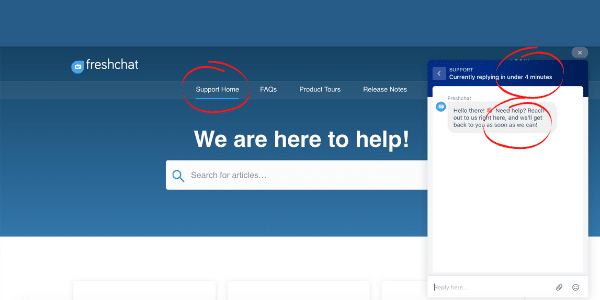
5. Get rid of the silos
Silos between teams build communication black holes—they lead teams to become self-feeding and self-destructive, and they often result in misalignments, conflicts, and all-around chaos.
Take the silos between your customer service reps, for example. If your business still uses one of those customer service tools that requires individual computer installation, your team has our sympathies.
A legacy software forces your agents to work separately from the rest of their team—physically as well as in terms of collaborating online.
When they need a hand with a customer issue from the product or engineering team, they have to leave everything behind and email or message people to find the right expert to solve the issue.
And if your customer service team uses multiple software programs, they’ll probably also take a longer time to take care of a customer’s problem because they’re forced to juggle different tools.
Naturally, this also means your customers’ data are scattered all over the place. Your agents will have to do the digital dance to glean information from all the platforms before they can solve a customer’s problem.
How to break silos in customer service:
- Unless you have a solid reason to continue using a “grandfathered software,” upgrade to a cloud-based collaboration platform now. It’ll make your agents—and customers—happy.
- Simplify your technology stack. Get a tool that unifies all your customer data in one place and allows your teams (even the ones outside customer service) to get everything they need in one app.
- When you add a new tool to your business (like a CRM or a marketing automation tool), make sure it also plays well with the existing apps in your customer service. For example, RingCentral integrates with Zendesk so that you can make and receive customer calls right in your Zendesk dashboard:
6. Measure the right metrics
While it’s true that you can’t manage what you can’t measure, focusing on the wrong metrics could seriously hinder your customer experience management.
Most contact centers these days use customer service metrics to benchmark their agents’ performance. It looks great at first, but sometimes this can be counterproductive.
Take average call handling time, for example. If you start measuring your agents’ performance based solely on this call center metric, soon enough they’ll rush through every customer interaction just so that they can hit their numbers.
And guess what happens when you set the wrong benchmarks—you scoop patience and empathy right out of the customer experience.
And, oh, the customer—likely rattled and grumpy at this point—might call over and over because they didn’t get the right kind of resolution the first time around. (Learn more about first call resolution standards.)
That further damages their experience—as well as your team’s overall performance metrics.
Brands like Zappos have built a fandom around their service experience because they don’t play by the same rules others set before them. Instead, they do what matters to them the most.
For instance, Zappos measures the success of its customer service reps with personal emotional connection (PEC).9 It’s not a metric you will find anywhere else in the world, because Zappos made that up:
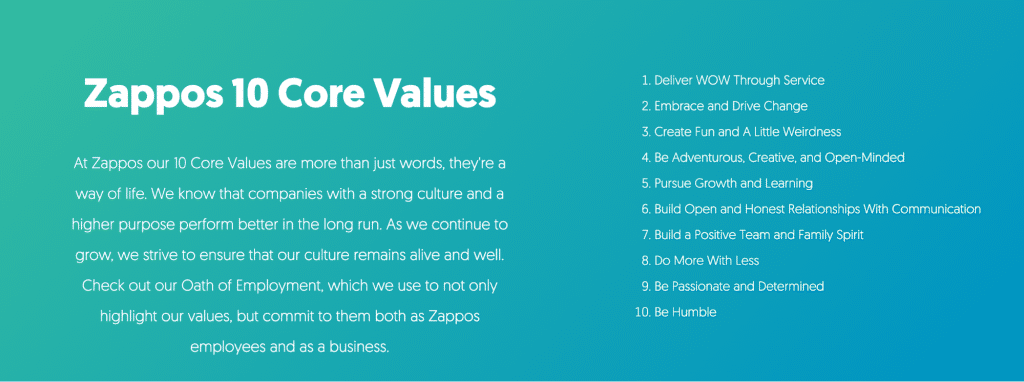
Zappos doesn’t believe in rushing their customers through a solution. The service reps at Zappos make sure their customers get what they want, but they also want customers to enjoy a moment of deep human connection while they’re at it.
We know—it sounds too good to be true, almost like a Disney movie.
But it’s these kinds of things that Zappos has done to crack the code of wowing customers—and it’s made them legendary for their customer service.10
In general, there are two types of customer service metrics you should be measuring:
- Customer-centric metrics (like first contact resolution, customer satisfaction, Net Promoter Score, and Customer Effort Score)
- Business-centric metrics (like customer churn rate, customer lifetime value, brand loyalty, and repeat purchase rate)
Improving the first set of metrics helps you build a strong rapport with your customers. Working on the second set of metrics helps you realize your profit goals.
How to measure the right metrics:
- Understand what a metric means to you. What story does a low CSAT or high call volume tell? What can you do about it? When you find an answer to that, you can identify what to measure.
- Don’t obsess over quantitative metrics like the number of customer queries, ticket volumes, and average resolution times. They’re indicators of performance, not necessarily success. Measure them and track them to fix your team problems, but don’t fixate on them.
- If you’re getting too many customer service questions, that means the problem lies somewhere else in your product or service experience. Fix that first.
- If you’re stumped, look at qualitative metrics like the average resolution rate, customer happiness, Customer Effort Score, and so on. These can help you identify what’s broken (or what’s good) in your service offering and make informed decisions to improve your customer experience.
- Don’t be afraid to go a different route and come up with your own metrics, like Zappos. Do what makes sense for your business.
7. Build self-service content
Let’s look at a brand example to understand the importance of self-service content in customer service.
You’ve probably heard of Mozilla. It’s the nonprofit parent company behind world-famous open-source products such as Firefox, Thunderbird, Bugzilla, Camino, Minimo, and a host of other online software solutions.
As of 2018, the company netted a yearly revenue of $436 million—with just over 80 staff.
But that’s not the surprising part. The surprising part is that despite its unstoppable growth, Mozilla doesn’t have a customer service department—at least not in the traditional sense.
For example, if you’re a Firefox user and you need help with configuration issues, you can’t dial a phone number or send an email to a support rep.
It’s not like Mozilla doesn’t realize the value of good customer service. It’s just that most of its support is either run by thousands of volunteers worldwide or the solution to a customer problem is to be found somewhere online—in one of their self-service portals.
Take a look:
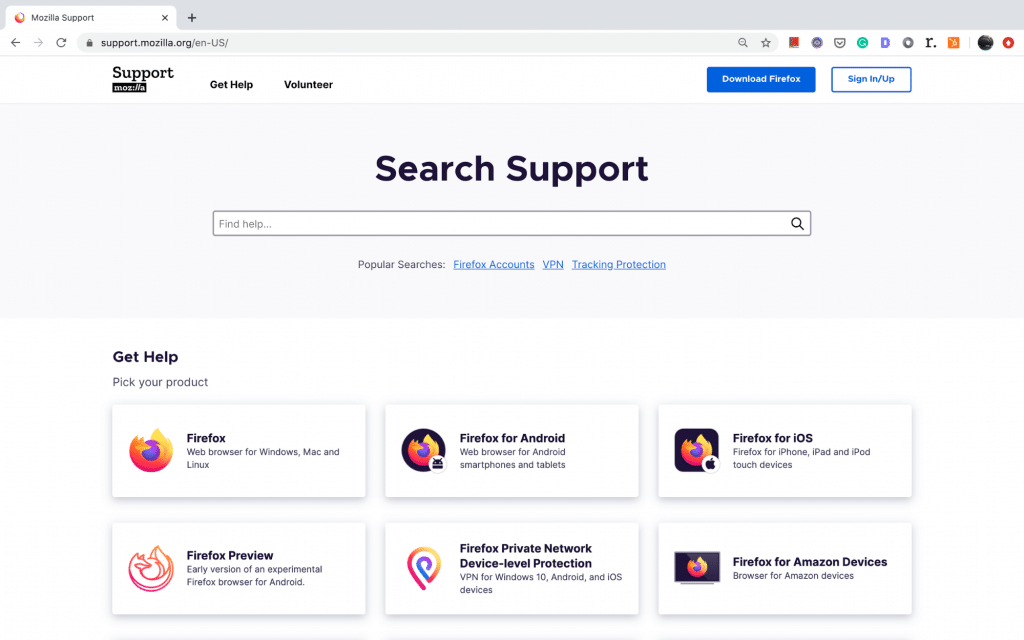
Now, we aren’t suggesting that you should start downsizing your customer support department—customers always crave some amount of human touch when interacting with brands.
But you should take a leaf from Mozilla’s page and start investing in self-service support.
Self-service has many advantages:
- It’s low cost, low maintenance, always-on, and scalable.
- People can find answers to their questions at their own convenience.
- It helps you divert a significant amount of traffic from your traditional customer service, especially during peak business seasons.
And here’s our favorite “hack” about building self-service support.
If you play your cards right (hint: search engine optimization), you can boost your organic traffic by ranking for the keywords that map to your customers’ search intent.
For example, if you own an online furniture store, you can create a self-service content portal to answer the most common problems people face with their home furniture and get more online visibility.
You could create blogs, guides, tutorials, and so on to cover topics like:
- Why is the leather on my sofa peeling?
- What is the difference between a king-size and queen-size mattress?
- What happens when my furniture warranty runs out?
- How to clean my furniture?
You get the drift. It’s a trick that’ll help your existing customers find answers to their questions while attracting new customers to your business.
How to build a self-service customer service:
- Write how-to blogs, frequently asked questions (FAQs), and video tutorials, and build a knowledge base on topics that your customer service gets asked about repeatedly.
- Make your self-service page compatible on all devices and platforms, such as mobile and desktop.
- If you have a chat widget on your website, embed the FAQs or other self-service content in the widget to help customers discover answers to their questions.
- Create an online community—either as an extension of your business domain or as an online group on Facebook or Linkedin—to let your existing customers help and interact with each other.
- Have someone from your team moderate these communities to keep your brand standards in check.
- Give incentives to the most active contributors in such communities, such as badges, verified status, and points to redeem rewards like discounts.
8. Build a direct feedback loop with customers
Who cues you in when your brand’s customer experience is going down the drain?
No amount of software or data from the latest industry report can tell you what your customers expect from you.
Your customers are your biggest and most direct source of data.
Your customers can tell you things that even your favorite business consultant with his MBA degree from Stanford can’t fathom.
But the problem is, very few customers are likely to come forward and tell you what’s wrong with your brand—until you go and ask them.
To take your customer service to the next level, you have to build a direct feedback channel to understand their minds. You have to proactively and frequently check in on them.
Asking for feedback from your customers tends to be more effective immediately after a service interaction:

How to build a direct feedback loop with customers:
- Survey your customers frequently. It’s the best way to know what your customers think about your brand, your product, and your support. It also shows that you care about their feedback.
- Remember customer satisfaction, Net Promoter Score, and Customer Effort Score? These customer service metrics also double as surveys. Embed these surveys as part of your product or service experience. If you keep scoring low, that means the CX is broken somewhere and you need to fix it ASAP.
- Never miss a chance to talk to your customers who call you to cancel their orders, ask for refunds, or opt out of your mailing list. Like Bill Gates once said, “Your most unhappy customers are your greatest source of learning.” Ask them what made them quit your brand so that you can stop other customers from leaving.
Put these customer service tips to good use
Here’s the thing about running a business that most people overlook. You can make your marketing, sales, and customer service much more effective if you understand basic human psychology.
When you understand what melts your customers’ hearts versus what ticks them off, you can create a wholesome customer experience that your customers will drool over.
But it’s definitely not as easy as it sounds. The bar for delivering good service experience has become extremely high in the past few decades.
Customers these days don’t compare the quality of your customer service to other businesses in your domain. They compare you with the best service that they have ever experienced or the top-notch service that everyone talks about.
In that sense, you are not competing with your direct competition anymore. You have the tall order of competing with the likes of Zappos. And to that end, we hope you will find the above customer service tips helpful in outgunning them.
1 zylotech.com/blog/customer-retention-vs-acquisition-the-great-debate
2 blog.hubspot.com/service/customer-retention
4 sharpencx.com/blog/zappos-customer-service/
6 salesforce.com/products/service-cloud/best-practices/important-customer-service-skills-list/
Originally published Mar 31, 2020, updated Jul 01, 2022


